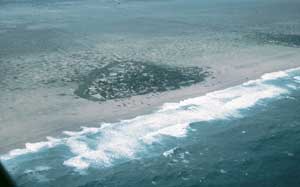According to a study, a fault line under the South China Sea west of the Philippines could cause a magnitude 9.0 earthquake and a tsunami. Within 2-3 hours, this tsunami could strike Vietnam.
Historical Tsunamis in Vietnam
The latest independent research conducted by a team of scientists from the Meteorology and Hydrology Institute (Ministry of Natural Resources and Environment) and the Institute of Geophysics (Institute of Science and Technology) shares a common view that Vietnam is in a region with a low risk of tsunamis; however, that does not mean we should be complacent.
Although there is no concrete evidence, leading experts in meteorology and geophysics believe that tsunamis have occurred in our territory.
 |
| Victims near Pangandaran beach injured during the tsunami on July 17 (Photo: Reuters) |
According to Dr. Vu Thanh Ca from the Meteorology and Hydrology Institute (IMH), a tsunami occurred along the coast of Thua Thien-Hue on September 11, 1904, destroying 22,027 houses, sinking 519 boats, and resulting in 724 deaths.
“There are documents suggesting that a tsunami struck the coastline of Nam Dinh in 1930 and Da Nang in 1964,” said Associate Professor Dr. Tran Thuc, Director of IMH. “However, there is no clear evidence to confirm or deny these claims.”
Notably, over the past 300 years, the Philippines, our neighboring country in the South China Sea, has recorded numerous specific tsunami incidents. Since 1677, there have been up to 16 tsunamis along the Philippine coast.
“It is highly likely that one of those tsunamis caused damage in our country without being documented,” Dr. Nguyen Thanh Ca stated.
Following the historic tsunami on December 26, 2004, in Indonesia that resulted in approximately 300,000 deaths, for the first time, the Institute of Geophysics (IoG) dispatched a team to investigate tsunamis led by Professor Dr. Nguyen Dinh Xuyen along the coastline from Dien Chau (Nghe An) to Deo Ngang (Ha Tinh).
The investigation revealed that several tsunami incidents had occurred in the surveyed area, causing numerous deaths and disappearances. However, the causes remain unclear. Therefore, “it is necessary to conduct surveys along the coastline of Vietnam,” emphasized Associate Professor Dr. Nguyen Ngoc Thuy, Director of IoG.
Importantly, the head of IoG has stated for the first time that the risk of tsunamis in Vietnam is real. “Seismologists must consider that earthquakes in the subduction zone west of the Philippines could reach magnitudes of 8.9 to 9.0 on the Richter scale, which means that the coastal areas and islands of Vietnam also face tsunami risks,” Dr. Thuy stressed.
According to some Japanese and New Zealand scientists, with whom two scientists from IMH had the opportunity to exchange ideas, earthquakes along the fault line submerged in the South China Sea west of the Philippines could indeed reach magnitudes from 8.4 to 9.0 on the Richter scale.
Tsunami Scenarios in Vietnam
Based on these assessments, two scientists from IMH utilized modern numerical modeling to calculate the propagation of tsunamis across the South China Sea to serve forecasting purposes and develop tsunami warning maps for Vietnam’s coastal areas.
Their research, titled “Numerical Modeling of Tsunami Propagation Across the South China Sea,” has garnered significant attention in the scientific community. This is the first time a tsunami scenario for Vietnam has been constructed with noteworthy data.
Assuming the fault line west of the Philippines generates a magnitude 9 earthquake, the likelihood of a tsunami occurring is nearly a reality. At the earthquake’s epicenter, the tsunami’s wavelength could reach 100 km, making it difficult to detect the tsunami while still far offshore. As it approaches the coast, the tsunami’s wavelength shrinks to about 30 m.
Using modern computational models, the two scientists determined the tsunami’s height at different time intervals and the sea level status from the moment the tsunami forms until it reaches the shores of Vietnam. Their numerical model has been evaluated by many experts as accurately simulating the tsunami propagation process.
 |
|
The sea area from Quang Ngai to Phan Rang |
According to their calculations, approximately one hour after the earthquake, the tsunami would have propagated to the Paracel Islands and Spratly Islands. Depending on the seabed topography around these islands, the tsunami height could be significant, possibly exceeding 5 meters.
About two hours after its formation, the tsunami would reach the Vietnamese coastline, significantly affecting the waters from Quang Ngai to Phan Rang. Da Nang would also be impacted by the tsunami, but to a lesser extent.
On the tsunami height distribution map along the coastline, it is observed that the tsunami height varies greatly along the coast. Almost throughout the mentioned coastal stretch, tsunami heights exceed 3 meters, one and a half times the height of the tsunami that recently occurred in Indonesia on July 17, which resulted in over 300 deaths.
In some areas, the scientists warned that tsunami heights could exceed 5 meters. They particularly noted that with a height of 5 meters at the coast, the wave height could surpass 10 meters. At this height, the tsunami could cause significant damage to coastal regions, comparable to the destruction caused by the tsunami at the end of 2004 in Indonesia.
Urgent Need for Tsunami Warning Bulletins
From these calculations, Dr. Vu Thanh Ca believes that to proactively respond to tsunamis, it is crucial to compute and issue tsunami warning bulletins for the islands in the Spratly and Paracel Islands. Alongside this, a tsunami warning system for our maritime areas needs to be established.
Simultaneously, while developing the tsunami warning system, it is essential to enhance education to raise community awareness about the risk of tsunamis, the signs of an impending tsunami, and measures to prevent tsunamis in high-risk areas.


















































